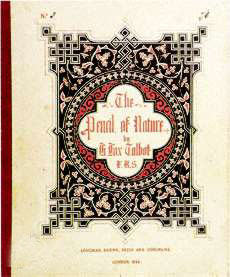|
© Copyright 2003 by the
Photography Criticism CyberArchive. All rights reserved. photocriticism.com |
 |
This printout is for reference only.
Reproduction and distribution of multiple copies prohibited. |
Archive texts:
History of Photography
The Pencil of Nature (1844-46)
Part I : Publisher's Leaflet, Frontispiece, Title Page
39, Paternoster Row, London
June, 1844.
JUST PUBLISHED.
PART I.
THE PENCIL OF NATURE,
by
H. FOX TALBOT, Esq.
The new art of PHOTOGRAPHY was announced to the world almost simultaneously in France and England, at the commencement of the year 1839, by M. Daguerre and by the author of the present work. The processes employed were at first kept secret, but when they became known they were found to be exceedingly different. The French method, which has received the name of the Daguerreotype, is executed upon plates of polished silver, while paper is employed in the English process. The Daguerreotype is now well known to the public, having been extensively used for taking portraits from the life, while the English art (called PHOTOGENIC DRAWING, or the CALOTYPE) has been hitherto chiefly circulated in private societies and is consequently less generally known.
It has been thought, therefore, that a collection of genuine specimens of the art, in most of its branches, cannot fail to be interesting to a large class of persons who have hitherto had no opportunity of seeing any well-executed specimens. It must be understood that the plates of the work now offered to the public are the pictures themselves, obtained by the action of light, and not engravings in imitation of them. This explanation is necessary, because some well-executed engravings have been published in France in imitation of Photography, but they want the character of truth and reality which that art so eminently possesses. Indeed, it is easy to see at once that the figures of men and animals in the foreground of the French engravings have been added only from the artist's fancy. The plates of the present work will be executed with the greatest care, entirely by optical and chemical processes. It is not intended to have them altered in any way, and the scenes represented will contain nothing but the genuine touch of Nature's pencil.
It is proposed to publish the Work in Ten or Twelve Monthly Parts, in Royal quarto, price Twelve Shillings each, each Part containing Five Plates, with descriptive letter-press.
The present Number includes some account of the Author's first discovery of the Art.
LONGMAN, BROWN, GREEN & LONGMANS.
Frontispiece/fascicle cover for The Pencil of Nature:

Text of title page of The Pencil of Nature:
N. 0
The
Pencil of Nature
by
H. Fox Talbot
F. R. S
LONGMAN, BROWN, GREEN AND LONGMANS
LONDON, 1844
***
The Pencil of Nature
BY
H. FOX TALBOT, Esq., F.R.S.
&c, &c, &c.
_________________
JUVAT IRE JUGIS QUA NULLA PRIORUM
CASTALIAM MOLLI DEVERTITUR ORBITA CLIVO.*
__________________
LONDON:
LONGMAN, BROWN, GREEN & LONGMANS,
PATERNOSTER ROW.
_______
1844.
_____________________
(verso)
J. & H. COX, BROTHERS, (Late COX & SONS,)
Printers to the Honorable East-India Company,
74 & 76 Great Queen-street* Note: In his Introduction to the 1969 facsimile edition of The Pencil of Nature (New York: Da Capo Press, 1969, unp.), Beaumont Newhall credits the Latin epigram above to Vergil's Georgics (III, 293), translating it as follows: "Joyous it is to cross mountain ridges where there are no wheel ruts of earlier comers, and follow the gentle slop to Castalia." Newhall adds, "To Talbot, a student of Greek mythology, the reference was evident: Castalia, on the slope of Mount Parnassus, was a spring dedicated to the muses; it was a fount of wisdom and knowledge." -- A. D. C.
For citation purposes, the specific online source for this text is: